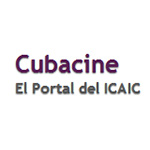 “Nuestro objetivo final es nada menos que lograr la integración del cine latinoamericano.
Así de simple, y así de desmesurado”.
“Nuestro objetivo final es nada menos que lograr la integración del cine latinoamericano.
Así de simple, y así de desmesurado”.
Gabriel García Márquez
Presidente (1927-2014)


-

El documental en Televisión Serrana (para un resumen de 2006)Por Dean Luis ReyesAlguna gente ha predicho la defunción de la Televisión Serrana. Tanto nos sorprenden las miradas reveladoras que sobre su mundo arrojan, que no les perdonamos cuando nos dejan sin sorpresa. Tras casi década y media de fundada en un remoto lugar de la geografía del Oriente cubano, justo en la Sierra Maestra, la TV Serrana se ha transformado en uno de los referentes obligatorios dentro del documental cubano contemporáneo. Cuando surgiera en 1992, bajo el empuje de Daniel Diez, realizador formado con Santiago Álvarez dentro de la nómina del Noticiero ICAIC Latinoamericano, sus propósitos más bien modestos eran dar cuenta de la realidad de la Sierra Maestra y sus habitantes desde una visión comunitaria del video.
Mas, para decretar defunciones está la realidad. Y los críticos somos una parte blanda, por oficio alarmista, de ella. Luego, hay cuestiones prácticas: desde que Daniel Diez pasara a otras funciones en la junta directiva del ICRT, se han sucedido continuas migraciones; tiempo después se iba Waldo Ramírez (La chivichana, Freddy o El sueño de Noel); recién, Rigoberto Jiménez se sumaba al claustro de la Escuela Internacional de Cine y TV de San Antonio de los Baños. La costumbre invita a pensar que lo acéfalo perece. Pero no: cambia.
De ahí que el esfuerzo creativo de los meses recientes haya culminado en una serie de talleres de formación para realizadores bajo el curioso apelativo de “Aprenda el uso del video”. Del mismo han salido cuatro cortos: Nely (dirección colectiva del taller número 5), breve esbozo de la personalidad de una mujer, típico documental de personaje; Pitingui (del taller 2), otro personaje, esta vez un carpintero con voluntad de acero; y Hombres de caminos (del taller 3), esta vez del personaje colectivo que significa una brigada de reparación de caminos serranos. Sobre todo los primeros adolecen de dificultades de criterio en el tratamiento de los individuos de la indagación, el planteamiento de problemas es escaso y de todo ello brotan conflictos de estructura y montaje. Sólo el último impone en el trabajo fotográfico y de montaje una atmósfera compleja, que trasciende la mera exposición de una estampa o personaje local, para alcanzar a rozar la grandeza del hombre y la maravilla de su industriosidad, el milagro que emerge de sus manos cuando las lleva el deseo (y la necesidad).
A propósito de necesidad, es ella la que empuja esta sobrevida de la TV Serrana. En permanente conflicto con la naturaleza, la inventiva cotidiana en la Sierra da lugar tanto a los talleres de video como a la invención de La cuchufleta. El corto de Luis Guevara tiene la consistencia del material reporteril para referir una invención a través de la cual un puñado de campesinos de un intrincado paraje ha resuelto la carencia de agua corriente. A falta de mejor nombre, la han bautizado así: la cuchufleta. Sin electricidad, pero con el río a media pedrada del bohío, no hay razón para cruzarse de brazos. Guevara le adosa no poca gracia al tratamiento sonoro y musical, atónito él mismo con la gracia y simpleza del dispositivo. Todas las entrevistas indican que aquí la vida se resuelve a base de inventiva y provisionalidad; viene una crecida del río, y a empezar de nuevo. Al cabo, todo es obra de la creación. Así que TV Serrana no muere, sino que se reinventa.
Y la obra más reciente de uno de sus creadores más sólidos, Rigoberto Jiménez (Las cuatro hermanas, Como aves del monte), está además en esta última producción. Rigo hizo EnNegro en una comunidad de Santiago de Cuba, lejos de San Pablo de Yao, sede de la televisora. Su tema vuelve a ser el misterio y los hombres que con él se codean. Solo que ahora tiene a mano un tema cercado de prejuicios ancestrales: el vodú. Esa cosmogonía, más que religión, parece tener allí un arraigo inimaginado: por un lado, comunidades nucleadas en torno a sus rituales y modo de vida; por la otra, un grupo de creadores de las artes plásticas que lo estudian, practican y utilizan como fuente de inspiración. Son sus palabras, así como las de un sacerdote que accede a mostrar parte de tan lacónico universo, quienes nos guían por un laberinto de enigmas al que el propio Rigoberto asiste como neófito. En verdad, su película nos deja azaeteados de dudas. Sin embargo, acaso el misterio que el realizador no consigue explicar hubiese quedado mejor expuesto sin la intención de develarlo y, sobre todo, sin el énfasis que pone en legitimarlo, en borrar el estigma que pesa sobre imágenes de sacrificios de animales, o rituales tildados de “salvajes” por el criterio eurocéntrico que nos amamantara.
Esta operatoria ligada con la indagación antropológica es uno de los aportes esenciales de la TV Serrana. La capacidad de representar sin la ambición de agotar el acontecimiento y, sobre todo, de hacer fluir el sentido a través del lenguaje y no a la inversa, es lo que ha colocado a varias de sus obras en el paisaje del audiovisual cubano de la última década. Entonces, cuando el miedo a verla fenecer de cansancio aparece, siempre hay algo que indica un nacimiento.
Ya había visto en Verano (2005) una compleja apuesta a narrar lo documental con imágenes y sonido. Por eso ahora que Roberto Renán aparece con Invierno, veo claro que su obra pudiera ser el anuncio de una dosis de complejidad impensada para el manejo testimonial de la realidad social en el audiovisual cubano. Preferiría una fotografía que busque menos el plano hermoso, la estetización, pero no puedo sino admirar la construcción dramática sin conflicto que hace Renán. Si en Verano era la calidez luminosa de Santa Cruz del Sur, aquí es el frío plomizo de la Sierra, las penumbras del bohío al amanecer y las filigranas que hace en el aire de la mañana el humo del fogón de leña; los niños desaliñados; la mujer ajada; los hombres que se baten con la tierra y siembran yuca en una falda ilógicamente empinada. La única advertencia de sentido textual es un texto sobre pantalla: “las estaciones no están en el año, sino en el alma”. Por eso sus documentales se trenzan con tiempo. Hay que ver la suerte con que hilvana espacialidad y temporalidad en un continuum pastoso que dice todo en el lenguaje metafísico de la poesía. El plano final es un golpe de efecto innecesario, pero la sutileza se aprende equivocándose.
Al cabo, la tarea (si alguna cabe) de TV Serrana quiere seguir siendo la de otorgar vida simbólica a esas comunidades raras, a personajes como en vías de extinción, a modos de vida distintos, a temporalidades que maticen las visiones que sobre el país tenemos. Sigue teniendo razón Nicolasito Guillén Landrián cuando ponía en Ociel del Toa: “Es bueno que esto lo vean en La Habana”. Sí, es bueno saber que otros abrazan valores que no son los míos.
 The documentary in Television Serrana (summary of 2006)
The documentary in Television Serrana (summary of 2006)
By Dean Luis Reyes
Some people have predicted the demise of Televisión Serrana. We are so surprised by the revealing glance of its world it shows, that we cannot forgive it when it leaves us unsurprised. Almost more than a decade and a half after its foundation in a remote place of the geography of the eastern part of Cuba, just in the Sierra Maestra, TV Serrana has become an essential referent of the contemporary Cuban documentary. When it appeared in 1992, under the drive of Daniel Diez, filmmaker who was trained by Santiago Álvarez as part of the payroll of ICAIC Latin American newsreel, its modest intention was to give account of the reality at Sierra Maestra and its inhabitants from a communitarian vision of the video production. But demises must be decreed by reality. And we critics are a bland part of it, for our fear monger occupation. Besides, there are practical issues: from the moment when Daniel Diez became a member of ICRT board of directors steady migrations have taken place, some time later Waldo Ramírez (La chivichana, Freddy o El sueño de Noel) also left, recently, Rigoberto Jiménez joined the teaching staff of International Movie and Television School at San Antonio de los Baños. Out of habit we tend to believe that something leaderless perishes. But it does not: it changes.
That is why; the creative effort of recent months has culminated in a series of training workshops for filmmakers under the curious denomination of “Learn the use of video”. The result has been four short length films: Nely (collective direction from workshop number 5), brief depiction of a woman’s personality, the typical character documentary; Pitingui (from workshop 2), another character, this time a carpenter with a steel willpower; and Hombres de caminos (workshop 3), this time a collective character, a repairing brigade working on the mountain trails. The first two documentaries suffer from criteria difficulties in the way the individuals inquired are treated, problems display is scarce, and from all this, a conflict in structure and plot arises.
Only the last of the three documentaries imposes a complex atmosphere in the work with photography and plot, which transcend the mere exhibition of a local character, and it manages to brush by the greatness of the man and the wonder of his laboriousness, the miracle that springs from his hands moved by desire (and necessity).
And speaking of necessity, it is the driving force for TV Serrana´s survival. In permanent conflict with nature, the everyday inventiveness in the Sierra makes room for video workshops in the same way they invent La cuchufleta. Luis Guevara´s short length film has the consistency of the reportorial material to narrate an invention made by a bunch of peasants from a faraway place to solve their lack of running water. For lack of a better name, they have named it like this: the cuchufleta. Without access to electrical power but with a river nearby, there is no reason to cross one’s arms. Guevara is very witty in the treatment given to sound and music astonished himself by the funniness and simplicity of the device. All interviews point at the fact that inventiveness and permanent provisional states are the means to solve the problems of their lives, when the river waters rise, they have to start all over again. In the end, everything is a work of creation. So, TV Serrana is not dying, it is reinventing itself.
And the most recent work of one of the most solid artists from TV Serrana, Rigoberto Jiménez (Las cuatro hermanas, Como aves del monte), is also part of this latest production. Rigo made EnNegro in a community of Santiago de Cuba, far from San Pablo de Yao, seat of the TV transmitting station. Once more his theme is mystery and the men who rub elbows with it. But now he has at hand a theme surrounded by ancestral prejudices: voodoo. This cosmogony, more than religion, seems to have an unimaginable rooting there: on one hand, communities grouped together around their rituals and ways of life, on the other hand, a group of plastic art creators who study, practice and use voodoo as their source of inspiration. Their words, like those of a priest who consents to shoe part of his laconic universe, guide us through a labyrinth of enigma in which Rigoberto himself participates as a neophyte. As a matter of fact, the film fills us with doubt. Nevertheless, maybe the mystery that the filmmaker does not manage to explain would have been better exposed without the intention of revealing it, and above all, without the emphasis he places in its legitimacy, in erasing the stigma that hangs over the images of sacrifices of animals, rituals considered “savage” by the European standards of our nurture.
This operational ways, combined with the anthropological inquest is one of the essential contributions of TV Serrana. The capacity to represent without the ambition of exhausting the event, and above all, the capacity to use the language to make the sense flow and not the other way around is what has placed several of his works in the landscape of the Cuban audiovisual of the last decade. Then, when we fear it might perish out of weariness, there is always a signal of rebirth.
I had already noticed in Verano (Summer) (2005) a complex way of using images and sound for the narrative of the documentary. That is why now, when Roberto Renán shows up with Invierno (Winter), I can see clearly that his work could be the announcement of a dosage of unexpected complexity in the way in which the testimonies of the social reality is handled in the Cuban audiovisual. I’d rather the photography was less tending to the beautiful, the aestheticism, however I have to admire the dramatic construction without conflict made by Renán. In Verano, it was the luminous warmth of Santa Cruz del Sur, here is the lead-colored cold of the Sierra, the semidarkness of the bohío (hut) at dawn and the fine handicraft made by the morning air in the smoke of the cook stove; the untidy children, the wither woman, the men fighting the land and planting cassava in an illogically steep mountainside. The only warning of textual sense appears on the screen: “seasons are not in the year, but in the soul”. That is the reason why his documentaries are weaved together with time. It is worth seeing how he reels off space and time in a pasty continuity which contains all in the metaphysic language of poetry. The final frame is an unnecessary attempt to cause effect but subtlety is learned through mistakes.
At the end of the day, TV Serrana´s task (in case it has one) is to continue to award symbolic life to those unusual communities, to characters in a sort of way to their extinction, to different ways of life, to the impermanent situations that diversify our visions of the country. Nicolasito Guillén continues to be right when he wrote in Ociel del Toa: “It is good that this is seen in Havana”. Yes, it is good to know that others hold values different from mine.
















